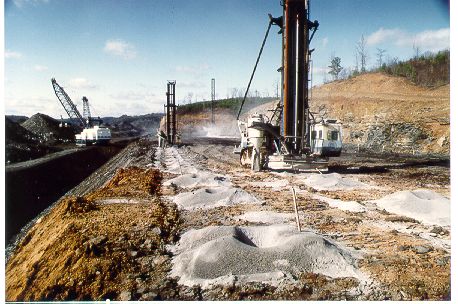Blasting
Blasting is an integral part of surface mining operations. To uncover coal reserves, the rocks overlying the coal are broken with explosives and excavated with various types of large earth-moving equipment. Without blasting, a vital part of the nation's energy reserve would be inaccessible.

Questions?
For more information, contact Toby Grzejka via email at [email protected] or via phone at (724)-312-9170.
The Surface Mining Control and Reclamation Act of 1977 (SMCRA) requires that coal mining be conducted in a manner that prevents injury to people and damage to public or private property during blasting. The side effects of blasting include:
- Flyrock - a rock or rocks moving through the air or along the ground after a blast and travel beyond the blast area (security zone).
- Ground vibrations - a seismic wave that moves through the ground following a blast.
- Airblast - a concussion (or pressure) wave that moves through air following a blast.
- Fumes - the gaseous byproducts that are the result of an explosives detonation.
- Dust - small particles of earthen material that may be temporarily suspended in air.
The most dangerous and apparent of these is flyrock. Injury or death to people and property damage may happen when a piece of rock is thrown beyond the permit boundary. The blaster is responsible for preventing flyrock and controlling ground vibration, airblast and fumes. OSMRE oversees the only national program to certify blasters. Training provided for blaster certification addresses the control of flyrock, vibrations, airblast and fumes by the appropriate use of explosives and hazard recognition in the field.
Ground vibrations and airblast may cause people's homes to shake. When people feel their homes shake, they may associate damage to their homes as being a direct result of blasting at a surface coal mine. OSMRE blasting regulations limit the amount of ground vibration or airblast that arrives at homes for the purpose of preventing structure damage. Some coalfield citizens claim that the OSMRE regulations do not adequately protect their homes and property. OSMRE set limits based on scientific studies that reasonably protect most typical residential structures. When the blasting limits are exceeded, violations are written and action may be taken against the blaster’s certificate. Occasionally, damage to homes is possible at vibration levels below the limits, particularly when structures aren’t representative of typical structures (e.g. adobe, log, or mobile homes). In these situations, OSMRE and the States are responsible for investigating the damage claim and/or adjusting limits to prevent damage.
If a home is damaged from a coal mine blast, a homeowner may receive compensation for or repair of the damage. Some property damage identified may pre-date the blasting and is caused by other natural factors (e.g., structure aging, poor foundation, normal stresses, runoff control, etc.) or improper construction. These damages are not the responsibility of the coal company.
OSMRE recognizes that people are sensitive to blasting vibrations and can feel blasts that are as little as 2% of the legal vibration limits. Thus, blasting that shakes their homes, but is within legal limits, may often annoy people. Depending on person’s sensitivity, any given blast may be offensive. While OSMRE does not regulate this annoyance, the regulations do recognize that people need advance warning. To help minimize annoyance, the rules require warning signals (audible to residents within ½ mile) that alert the public of impending blasts. The meaning of the signals and the specific blasting times are provided in a blasting schedule notice that is mailed to residents within ½-mile of any blasting. Additionally, homeowners can ask questions about the blasting during the pre-blasting survey of their home (available to residents within ½ mile of coal mining permit boundaries).
The following states have blasting related documents that discuss the blasting process and regulatory guidelines for the use of explosives.
Ohio - Blasting in Ohio's Quarries and Surface Coal Mines
Pennsylvania - Citizen's Guide to Explosives Regulations in Pennsylvania
West Virginia - Citizen's Guide to Blasting
Kentucky - Citizen's Guide to Coal Mine Blasting
Indiana - Citizen's Guide to Coal mine Blasting in Indiana
Virginia - Minimizing the Off-Site Effects of Blasting
ARblast: State regulatory authorities are required to set vibration limits at a wide variety of structures on a case-by-case basis as part of the permit blast plan. Documents that are useful in justifying these limits can be found at the Pennsylvania Department of Environmental Protection, Blasting Research Papers webpage.
Federal Registers: The following documents form the basis for the OSMRE regulations. Many iterations of the rules, in part, require review of multiple documents to obtain a complete understanding of the existing rules. The enabling verbiage in the Surface Mining Control and Reclamation Act of 1977 (SMCRA) are found in the Use of Explosives and Certification and Training of Blasters sections, 515(b)(15) and 719, respectively.
- 1986 Federal Blaster Certification Program Preamble
- 1983 State Blaster Certification Template Rule Preamble
- 1983 Final Blasting Rule Preamble
- 1982 Proposed Final Blasting Rule Preamble
- 1979 First Blasting Rule Preamble Blast Plans ; Performance Standards
- 1978 First Proposed Blasting Rule Preamble : Blast Plans ; Performance Standards
Reclamation Inspectors are trained to understand the science of blasting and the Use of Explosives regulations. The Blasting and Inspection class helps the inspectors become conversant in blasting terminology to ensure effective communications in the field and ability to understand blasting records.
For more information on courses offered by the National Technical Training Program, please visit: https://www.osmre.gov/programs/national-technical-training-program

